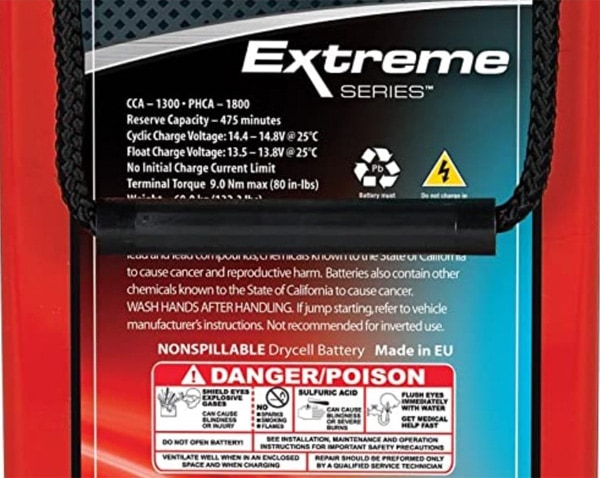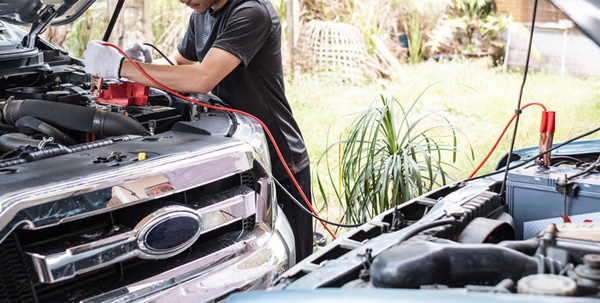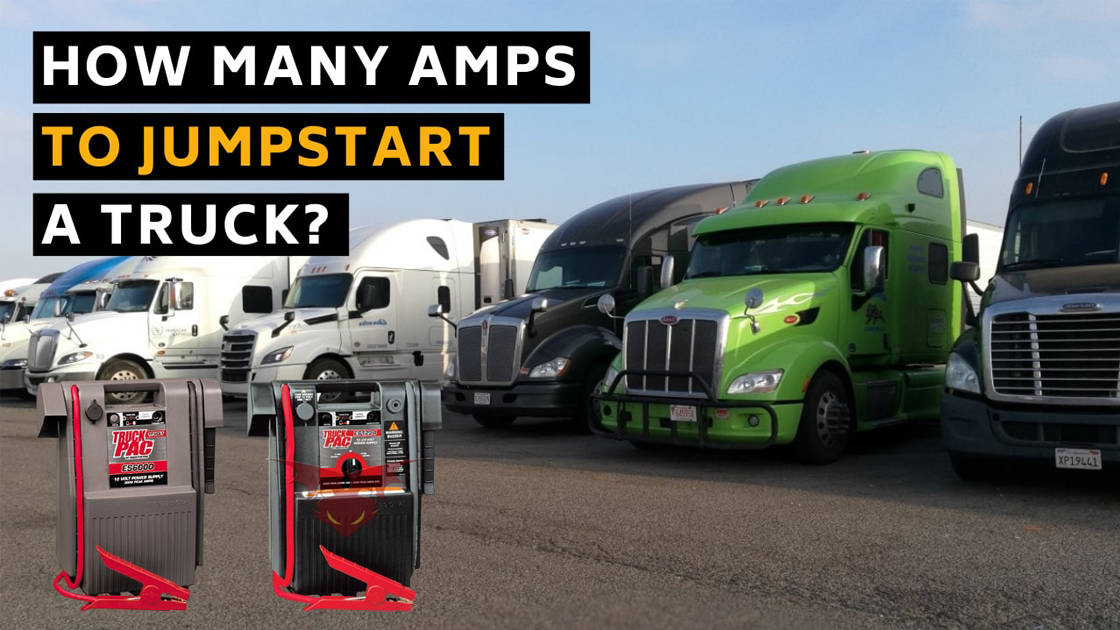It’s about the Christmas season, and you’re excited to get out of the house, preparing for the special time of the year. But luck just isn’t on your side. After many times trying to turn the ignition key, your truck is not moving. About one to two seconds later, you realize the battery is dead because the light was on for the whole night.
You don’t feel like calling AAA or any company for help; therefore, the only option left is to jumpstart the truck yourself! However, the question of “how many amps to jumpstart a truck” might bother you a little bit. Even though there are different ways you can jumpstart and many factors to consider while reviving the vehicle, what about amps?
Let’s dive right into the article and find the answer for your darling!
How Many Amps to Jumpstart a Truck?

Car With Dead Battery (cre:tswpanel.ca)
We understand that not all drivers know how to use portable jump starters, and not all of them are familiar with the concept of bringing a car back to life using amps. Therefore, they often ask themself such questions: “How many amps does it take to jump-start a truck?” or “How many amps to jump-start a semi-truck, or even a diesel truck?” Many factors can affect the number of amps needed in an automobile, and the first factor is engine size.
Vehicle Engine Size
For different sizes, we will have other amps required. As a result, enough cranking amps to jumpstart an average car might not be the same amps needed to jumpstart a truck.
For example, a small engine like a compact car only needs 200-600 peak amps for an initial boost. Imagine having a 700-amps jump starter; you certainly can give some extra juice to any economical or city car with amps below 700. However, with bigger battery power, like 800 amps, this might be insufficient. The amps and the vehicles’ sizes share quite a strong connection, when one goes up, the other follows suit. In the cases of giants like trucks or SUVs, the amount required never falls below 1000 amps, and for certain models, it might shoot to 2000.
Have you ever wondered how many amps jump-start a diesel truck? A diesel engine will need more amps, and the amp’s current may vary in size; especially a bulkier one might require up to 1000 amps. And how many amps does it take to jump-start a semi-truck? The answer is 1500-2000 amps and 24 volts.
Oil and Temperature
The fuel used in the car plays an essential role in determining the amps. An engine with less viscous oil will set up more quickly and require fewer amps than the bigger one. When it’s winter, and the temperature gets frigid, the oil will be thicker and resist a free flow. For this reason, the battery draws a higher amount of amps current in a cold environment.
As we all know, trucks require around 500-1000+ amps; however, they might need more than 1200 amps to boost when low-temperature hits. Then how should we calculate this “high amount of amps in cold weather?”
When it’s 32 degrees Fahrenheit and the temperature is considered warm, you can just use the CA rating to decide. However, if it’s in winter (0 Fahrenheit), it’s time to switch your eyes to the Cold Cranking Amps (CCA) rating. Because in a frigid environment, electrons in batteries slow down which will need more amps to kick off. Any amps lower than the CCA rating will not get enough power to the car’s ignition system.
Therefore, the Cold Cranking Amps rating in the truck battery is an indication that drivers have to know by heart if they live in cold regions. In the battery’s label, we will see information such as Cold Cranking Amps (amps for frigid weather), Cranking Amps (amps for average temperature), Voltage (important when looking for a suitable device), and other code numbers. You can simply base on this info and find the amps you need.

Truck Battery Label
Nowadays, we have jump packs that can automatically calculate the amp current needs for charging, which means you don’t have to waste your time searching for a sufficient number of amps for your truck. But if you don’t want to spend your extra money buying an advanced device like that, then the CA and CCA labels on the battery are what you should search for.
Additional Factor To Consider
Do you think getting the right amps for your truck only needs to consider those two factors above? It’s true that you only have to look for the CCA and CA ratings to find amps. However, there is an additional factor that does not guide us to the number of amps but will affect your decision in choosing the device to jumpstart. It’s the voltage.
The power cells of your automobile are just as crucial as the amps capacity indicator. You can either look on the car company’s site, on battery labels, or use a voltage measurement (a multimeter) to define the voltage range.
Most trucks, like a diesel-operated ones, feature a system of 12V or 24V. You have to find the jump starter or vehicle with the SAME accumulator voltage for your car to kick off.
For example, you have two jump starter powers with the same amps of 1000, and your truck needs exactly that number of amps. Which one will you choose? Do you think your truck can use both jump starters?
Well, let’s the voltage decide. If your dead battery has lower power cells (e.g. 12 volts) than the power source (24 volts), the truck battery will likely be damaged (your lightbulbs might even blow up). This is due to the ejection of the acid mixed with hydrogen bubbles, causing an explosion.
In a reverse situation, if your truck battery has higher volts than the supplier volts, no explosion will occur. But in the long run, your truck battery and the power source will crash down. Therefore, finding the right amps is essential, but choosing the correct voltage battery is also crucial.
Related:
- How Many Amps Is A Car Battery to Ramp up Your Engine?
- How To Jump A Car Without Another Car?
- Peak Amps Vs Cranking Amps Vs Cold Cranking Amps Jump Starters
- How To Use A Jump Starter: Detailed Guideline For The Unprofessional
How to Jumpstart a Truck?
As we’ve mentioned before, there are two methods, and each method requires different devices and tips.

Jumper Cables
We’ll kick off with the first method: using jumper cables.
- Step 1: You need a pair of quality jumper cables and another operational vehicle’s battery.
- Step 2: Shut off the ignition in both vehicles and let them face each other about 18 inches apart.
- Step 3: Open your truck’s hood and attach the red clamp of jumper cables to the dead battery’s positive terminal.
- Step 4: Go to the other car. Attach red and black clamps on the positive and negative terminals, respectively, on that car’s battery.
- Step 5: Go back to your truck. The last black clip should be clamped on an unpainted surface that isn’t near the surface. DO NOT clip the black cable on any of the battery terminals!
- Step 6: Run the working vehicle for about 2-3 minutes and after that, try to start your truck.
That’s how you jumpstart a truck with jumper cables. Easy, isn’t it? The only downside of this method is that you’re dependable on another vehicle.
How about the method with a portable jump starter? In any case of emergency, this method is widely recommended. A handy and convenient portable jump starter will save the situation; mostly, it does not require other cars’ help.
- Step 1: Shut down your engine and pull out your heavy-duty jump starter!
- Step 2: Attach the red and black clamps to the battery’s positive and negative terminals.
- Step 3: Turn on the jump starter and wait for 3 minutes
- Step 4: Re-start your truck.
And things are set!
Keep in mind that these two methods are just to kick-start the battery. They’re used as emergency backups only; therefore, do not mistake them for a car battery charger.

Start the truck with another car
Jumpstart Too Few Amps Can Damage Your Truck
If your car’s capacity needs 700-amps current, then a 1300 amps portable jumper can handle it. What if the case reverses? What if you have a 1300 amps battery and a 700-amps jump starter, will these damage your battery?
The answer is: yes. Even though some drivers claim that using smaller-amp power packs would work, every part of the car will be damaged. In the long run, the jumper leads, batteries, starter motor, battery plugs, or alternator will collapse. The portable jump starter will also be damaged.
How about you are somehow in the middle of a snowy town and you’ve discovered your dear truck needs a jumpstart to revive? Now, you know the CCA numbers in your truck battery and the portable jump pack are what you have to look for. Unfortunately, the CCA on the jump pack is 1000, and your truck battery needs 1500 amps of current.
Should you just go and give it a try? No, don’t do that. Any amps lower than the Cold Cranking Amps rating will not get enough power to the car’s ignition system. Besides, it will require extra heat and stress, which reduce the lifespan of your engine compartment.
It would be best if you also were careful while doing any of the two methods above. Especially, if the cables to the car battery’s positive and negative terminals touch each other, the battery will create a spark, ignite flammable vapors and cause itself to explode.
In Conclusion
Whew! We’ve come to the end of the article. Now, do you know how many amps to jumpstart a truck and where to look for the amps required? I hope you do. The bottom line is that jump starting a truck depends on different factors and whether you use size jump starters or jump cables, these factors will remain crucial in choosing the right amps for your truck.
We hope after reading this article, you will be able to save your money, and time, as well as your truck battery life and quality.
Further Reading:
WHAT'S NEW
The best AGM battery chargers will be the ideal option to revive your flat battery without relying on professional help. These handy high-tech chargers are extremely beneficial because they offer...
The Genius Boost GB40 is popular because of its ability to help boost your vehicle when it has battery issues. Many of our customers wonder why the Noco GB40 can work greatly like so. So, we have...

